Understanding How to Return to Exercise After an Injury: A Step-by-Step Guide
In this article, we’ll explore a comprehensive 10-step guide on how to return to exercise after an injury, empowering you to regain strength and confidence safely.
Returning to exercise after an injury is a journey that many face, and it’s more common than you might think. Statistics show that around 50% of physically active people experience some form of injury in their lifetime. Whether it’s a minor strain or a more serious issue, injuries can disrupt your routine and leave you wondering how to safely get back to your workouts. One of the most frustrating parts about getting injured is the sudden halt in progress. The body you’ve worked so hard to strengthen feels weak, and the fear of re-injury can make you hesitant to start moving again. These concerns are valid and entirely normal. The good news is that with the right approach, returning to exercise after an injury can be done safely and effectively, helping you rebuild your strength, confidence, and fitness levels.

When you’re sidelined by an injury, it’s common to feel a mix of emotions—frustration, anxiety, and even fear. You might worry about losing the progress you’ve made, or that returning to exercise too soon will cause further damage. These are valid concerns, but with the right plan, you can regain your fitness and get back on track. The key is taking it step by step, respecting your body’s healing process, and understanding that there’s no rush to get back to your previous fitness level. In this article, we will provide a step-by-step guide on how to return to exercise after an injury, combining practical advice and informative explanations of why these steps are important. You’ll learn not only what to do but how and why these strategies work.
The first thing to understand is that injuries need time. Rushing back to your regular routine without giving your body enough time to heal can increase the risk of re-injury or cause chronic issues that may take longer to resolve. It’s tempting to push through the pain, but this can be counterproductive in the long run. A careful balance between rest and rehabilitation is necessary to allow the injured area to recover fully. Consulting a healthcare professional before resuming exercise is always a good idea. Whether it’s a physical therapist, a doctor, or a sports trainer, getting expert advice will help you understand the extent of your injury and what activities to avoid as you start moving again.
Once you’ve been cleared to return to exercise, start slow. Even if you were in peak condition before your injury, you won’t be able to jump back into the same level of intensity. Your muscles, tendons, and ligaments need time to adapt, and jumping into intense activity too soon can lead to setbacks. Begin with low-impact exercises that are easier on your joints and muscles. Activities like walking, swimming, or cycling are great options to start with as they promote movement without putting too much strain on the injured area. The goal is to gradually increase your activity level while monitoring how your body feels.
Pain management is also a critical aspect of figuring out how to return to exercise after an injury. It’s important to differentiate between normal post-exercise soreness and pain that indicates something is wrong. A good rule of thumb is that soreness should feel like mild discomfort, but any sharp, intense, or lingering pain could be a sign that you’re pushing too hard. If you experience pain, take it as a sign that you need to back off and give your body more time to heal. It’s also crucial to pay attention to swelling or stiffness, as these are indicators that the injured area might still be recovering.
Subscribe And Get Our Free E-Book:Unlocking The Power Of Nutrition-Supplements, Substitutes, and Superfoods!
In addition to starting slow, rehabilitation exercises designed specifically for your injury are an essential part of returning to exercise safely. These exercises not only help to restore strength and flexibility but also ensure that the injured area is fully capable of handling physical activity again. For example, if you’ve had a knee injury, your rehab might include strengthening the muscles around the knee to provide more stability. If it’s a shoulder injury, you might focus on range-of-motion exercises to improve flexibility and prevent stiffness. By incorporating these targeted movements into your routine, you’ll build the necessary strength to avoid re-injury.
Throughout this process, consistency is more important than intensity. It’s better to focus on gradual progress than to push yourself too hard too soon. Doing a little bit each day—whether it’s stretching, mobility exercises, or light cardio—will add up over time. This gradual approach also allows your body to build endurance, strength, and flexibility in a way that minimizes the risk of further injury.
Another key element in learning how to return to exercise after an injury is to listen to your body. If something doesn’t feel right, don’t ignore it. Modify your routine if necessary. For example, if a particular exercise causes discomfort, switch to something less strenuous or adjust the movement. The goal is to avoid aggravating the injury while still making progress.
Rest and recovery are just as important as exercise when recovering from an injury. Many people make the mistake of thinking they need to constantly be active to make progress, but that’s not true. Your muscles repair and grow during periods of rest, and this is especially true after an injury. Incorporating proper rest days into your routine will give your body the chance to heal fully. Recovery techniques such as stretching, foam rolling, and using ice or heat therapy can also help reduce muscle tension and promote healing.
Finally, patience is crucial when figuring out how to return to exercise after an injury. It’s natural to want to get back to your regular workouts quickly, but rushing can lead to long-term setbacks. The key is pacing yourself, gradually increasing your activity level, and following rehabilitation exercises tailored to your needs. Over time, you’ll find that your body becomes stronger and more resilient, allowing you to return to your workouts with confidence.
In short, understanding how to return to exercise after an injury is a process that involves a balance between rest, rehabilitation, and careful progression. By following practical advice, listening to your body, and giving yourself the time you need to heal, you can safely return to your fitness routine without risking further injury.
The chart below outlines a phased approach to injury recovery, helping guide you through each stage of returning to exercise. It breaks down the key phases, from the immediate aftermath of an injury to full recovery, along with specific goals and recommended activities for each stage.
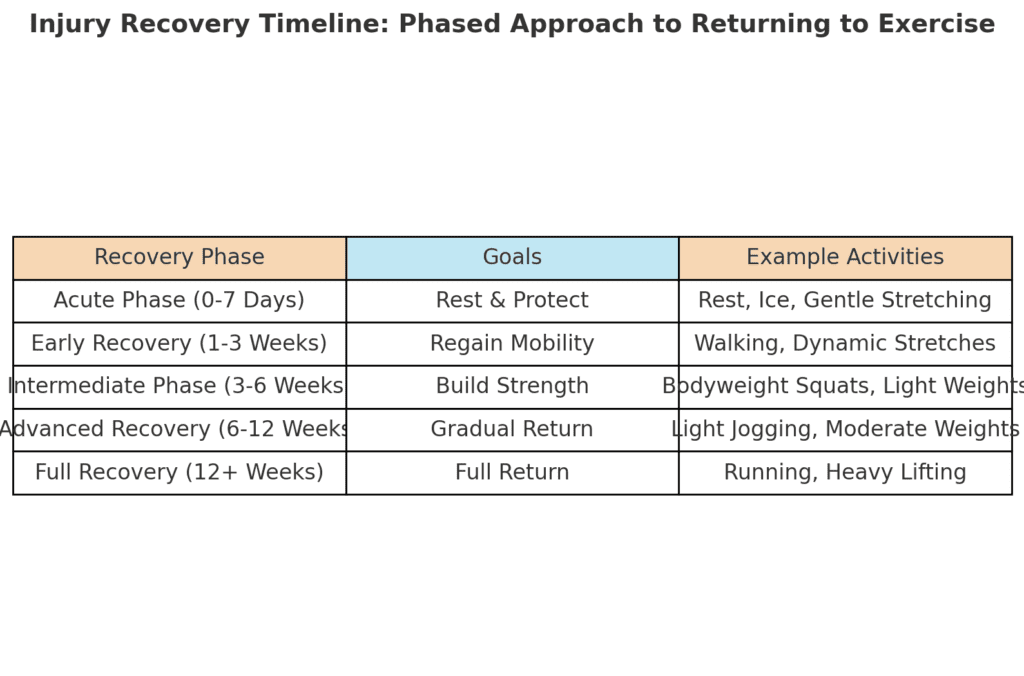
This recovery timeline emphasizes the importance of progressing slowly and listening to your body. By following these phases and incorporating the suggested activities, you can ensure a safer and more effective return to exercise while minimizing the risk of re-injury.
How To Recover From Any Injury Video
Assessing Your Injury: Step 1 – Listen to Your Body
It’s surprising how often people overlook their body’s signals when recovering from an injury. Research shows that 75% of people return to exercise too soon, often because they ignore early signs of discomfort or pain. Listening to your body is crucial when figuring out how to return to exercise after an injury, as it can help you prevent setbacks and further complications. Many people underestimate the power of rest and recovery, or they push themselves because they’re eager to get back to their routine. However, rushing into activity without fully understanding your body’s condition can lead to more serious issues down the road.
The first step in your journey of how to return to exercise after an injury is assessing how your body feels and knowing when to stop. This means paying attention to signals like pain, swelling, and weakness, but also recognizing subtle cues such as tightness or stiffness that could indicate your body isn’t quite ready yet. Sometimes, it’s tempting to push through discomfort, but this can lead to re-injury. Recovery isn’t a race, and it’s better to take a slow, controlled approach than to end up back at square one because you ignored your body’s warnings.
Practical Tip: Consult a Professional
Before you even think about heading back to the gym or resuming your regular workouts, it’s important to get a professional opinion. Whether you see a doctor, physical therapist, or sports medicine specialist, their expertise is critical in assessing your injury’s severity and providing a clear roadmap for recovery. They’ll evaluate whether the injured area has healed enough to handle physical activity and can also recommend specific exercises or modifications to ensure you’re not aggravating the injury further. A professional can also monitor your progress over time, helping you make adjustments to your exercise routine as you recover.
When it comes to how to return to exercise after an injury, getting that professional clearance is crucial because it gives you confidence that your body is ready for physical activity. Without this guidance, it’s easy to make the mistake of starting too early or pushing yourself beyond your current capacity. You don’t want to guess when it comes to your health, so investing the time to consult a professional ensures that you’re on the right track.
Pain vs. Discomfort
One of the most important lessons you’ll need to learn during your recovery is the difference between pain and discomfort. Many people assume that any type of soreness is normal when returning to exercise, but this isn’t always the case. While some discomfort is a normal part of rebuilding strength and flexibility, pain is a warning sign that something is wrong.
Pain usually indicates that there’s inflammation, damage, or further injury occurring. It can feel sharp, stabbing, or intense, and should not be ignored. If you experience this type of sensation, it’s a signal to stop what you’re doing immediately and seek further evaluation. On the other hand, discomfort is often a sign that your muscles are working and healing. It feels more like a dull ache or tightness and usually resolves after a few hours or with proper rest.
Understanding this distinction is essential in how to return to exercise after an injury. Discomfort can be managed through gradual progression and allowing the body to adapt, but pain needs to be respected. If you find yourself questioning whether what you’re feeling is pain or discomfort, it’s better to err on the side of caution and take a break.
Explanation: Why Consult a Professional?
You might wonder why seeing a doctor or physical therapist is necessary, especially if your injury feels minor or you’ve dealt with similar issues in the past. However, the reality is that even minor injuries can develop into long-term problems if not handled correctly. A professional has the experience and tools to accurately assess your injury’s current state. They can perform strength tests, check for mobility issues, and even order imaging if necessary to ensure that everything is healing as it should.
Another advantage of working with a professional is that they can create a personalized rehabilitation plan for you. While general advice can be helpful, each injury is unique, and a tailored approach is always better. For instance, they may recommend specific exercises to strengthen the muscles around the injury, or they might give you strategies for managing pain and inflammation during your recovery. This guidance can make all the difference in ensuring that you return to exercise safely and efficiently.
Lastly, professionals can also monitor your progress over time, ensuring that you’re moving at a healthy pace. Recovery isn’t linear, and some weeks may feel better than others. Having a professional who can track your progress and adjust your routine based on how your body responds is an invaluable part of learning how to return to exercise after an injury.
Pain vs. Discomfort: Breaking It Down
To further clarify, let’s break down what pain versus discomfort might look like during your recovery. Pain is typically intense, sharp, and sudden. It may worsen with continued movement and doesn’t improve with rest. For example, if you feel a sharp twinge in your knee during a run, or your shoulder aches sharply while lifting, these are clear signs to stop immediately. Continuing with this kind of pain will likely lead to further damage.
Discomfort, on the other hand, is more like a dull, lingering ache or tightness. It’s usually manageable, and you can still move without feeling restricted. For example, after a workout, you might notice a mild soreness in the muscles you worked. This feeling is generally okay as long as it’s temporary and fades with rest. In fact, some discomfort can be a positive sign that your muscles are adapting and getting stronger, especially if you’re working on rehabilitation exercises specifically designed to help your recovery.
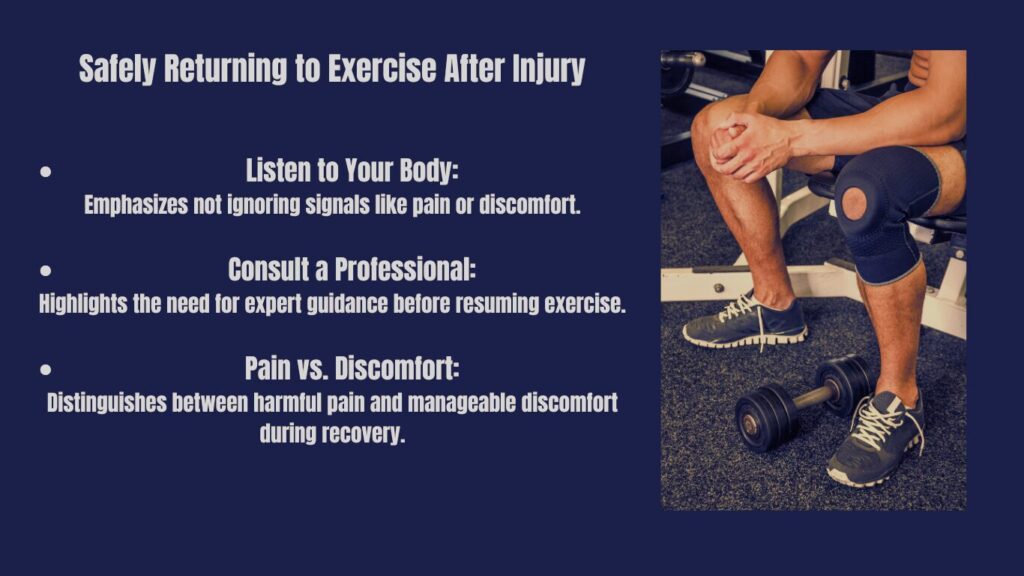
The key to mastering how to return to exercise after an injury lies in respecting these signals from your body. Pushing through pain is never the answer, but discomfort can be used as a guide to gradually rebuild strength and resilience in the injured area. As you progress, you’ll likely notice that the discomfort becomes less frequent and that you’re able to handle more activity without any adverse effects. This is a sign that your body is healing and adapting to the increased load.
The first and most critical step in understanding how to return to exercise after an injury is to listen to your body and assess its readiness for activity. Start by consulting a professional who can provide an accurate evaluation and guide your rehabilitation. Learn to distinguish between pain and discomfort, using these cues to pace your recovery. By taking these steps, you can safely return to your exercise routine without risking further injury.
Set Realistic Expectations: Step 2 – Be Patient and Start Slow
Did you know that studies have shown it can take up to three times as long to recover fully from an injury as it did to develop the injury in the first place? This is why setting realistic expectations and approaching your recovery with patience is absolutely key when thinking about how to return to exercise after an injury. Many people are eager to jump right back into their previous routines, but the truth is that recovery requires not only time but a thoughtful, slow reintroduction to physical activity. Patience isn’t just important for your body’s healing process; it’s crucial for your mental well-being, too. Rushing through recovery often leads to re-injury, frustration, and ultimately a much longer setback.
Practical Tip: Start with Gentle Movement
The first practical step when considering how to return to exercise after an injury is to begin with low-impact, gentle movements that promote healing without putting too much strain on your body. Depending on the nature of your injury, this could mean activities like walking, stretching, or light swimming. These types of exercises are excellent because they get your body moving and improve circulation, which helps in the healing process, without the risk of overloading your muscles or joints.
For example, if you’ve had a leg injury, walking on a flat surface is a great way to reintroduce movement. If your upper body was injured, simple range-of-motion exercises or light resistance band work can help you slowly regain strength. The goal at this stage is to restore mobility and flexibility in the affected area, not to build strength or endurance right away. Gentle movements can also help reduce stiffness and ensure that your body is functioning properly before moving on to more intense forms of exercise.
Starting slow is not only about avoiding further injury—it’s about rebuilding confidence. If you’ve been sidelined by an injury, it’s natural to feel unsure about moving again. Starting with movements that feel safe and easy can help restore your confidence in your body’s ability to heal and move again.
Limit Intensity
When you’re ready to start increasing your activity, it’s important to limit the intensity of your workouts. A general rule of thumb is to use 50% of your pre-injury effort when you first return to exercise. This means cutting your previous workout routine in half in terms of both intensity and duration. If you used to run for 30 minutes, start with 15. If you lifted heavy weights, switch to lighter ones or use bodyweight exercises to begin with. This reduced effort ensures that your body has time to adapt to movement again without being overstressed.
Gradually, you can begin to increase the intensity of your workouts by no more than 10% each week. This means adding a little more time, weight, or intensity to your sessions but in very small increments. For instance, if you start by walking 15 minutes a day, the next week you might increase to 16 or 17 minutes. Following this gradual progression allows your body to strengthen and rebuild without overloading the areas that are still recovering.
Explanation: Why Start Slowly?
After an injury, your muscles, tendons, and ligaments are weaker and need time to return to their previous strength. These structures become deconditioned during your recovery period, which means they are more vulnerable to strain and injury when you begin moving again. If you rush back into high-intensity workouts too quickly, you run the risk of further straining these weakened areas, which could lead to setbacks in your recovery or, worse, re-injury.
The temptation to return to your old routine is understandable—after all, it’s what you’re used to—but your body simply isn’t ready for that yet. When you’re learning how to return to exercise after an injury, it’s important to understand that muscles take time to regain strength and mobility. Starting slow ensures that your body has the chance to adapt to movement again, gradually rebuilding strength without causing further damage.
By beginning with gentle, low-impact exercises and slowly increasing intensity, you’re allowing your muscles, tendons, and ligaments to adapt to the stresses of physical activity. This gradual approach helps prevent re-injury and ensures that your body has the proper time to heal fully.
The 10% Rule: Gradual Progression
A common recommendation when it comes to building back strength after an injury is the 10% rule. This guideline suggests increasing the intensity or duration of your workouts by no more than 10% per week. The idea behind this rule is that it allows your body to gradually adapt to increasing levels of stress, preventing you from overloading muscles, joints, or tendons that are still in recovery mode.
Let’s break this down. If you start by walking for 15 minutes a day, the following week, you would only increase that time by 1.5 minutes. This small progression allows your muscles to recover from the previous week’s workload without pushing them too hard. If you’re lifting weights, the same rule applies: increase the amount you lift by no more than 10% each week to ensure that you’re strengthening your muscles in a controlled and safe way. This slow, steady progression is the best approach when figuring out how to return to exercise after an injury, as it minimizes the risk of re-injury while still allowing you to make progress.
The 10% rule is a helpful framework because it’s easy to follow and gives you a clear path forward in your recovery. While it might feel slow at first, it’s a reliable way to make consistent gains without overdoing it. This gradual increase helps strengthen weakened areas without the risk of overload, allowing you to slowly regain your previous fitness levels over time.
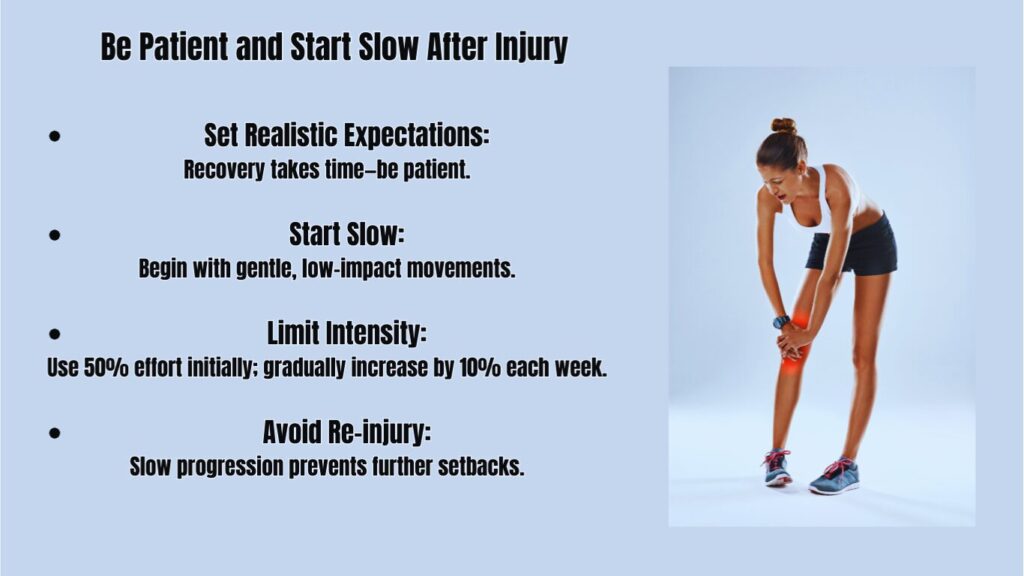
The second key to understanding how to return to exercise after an injury is setting realistic expectations and starting slow. Begin with gentle movements like walking or stretching to reintroduce your body to activity, and gradually increase intensity by no more than 10% each week. This approach gives your muscles, tendons, and ligaments the time they need to rebuild strength and mobility without risking further injury. Being patient with your progress and focusing on small, consistent improvements will set the foundation for a safe and effective return to exercise.
While it may be tempting to rush back to where you were before your injury, remember that taking things slow now will help you get there sooner in the long run—without the setbacks of re-injury.
Focus on Range of Motion Before Strength: Step 3 – Improve Flexibility and Mobility
Did you know that research shows loss of mobility is one of the most common issues people face after an injury? Studies have found that even mild injuries can lead to stiffness, which, if left unaddressed, can impact the way you move long after the injury itself has healed. When you’re thinking about how to return to exercise after an injury, it’s important to focus on regaining your range of motion before jumping back into strength training or endurance workouts. Flexibility and mobility are the foundation upon which you rebuild strength, and neglecting them can slow down your recovery or make you prone to future injuries.
After an injury, muscles and joints often become tight, reducing the range of motion in the affected area. This limitation can prevent you from performing exercises correctly and might even cause compensatory movements that strain other parts of your body. The key to a successful return to exercise is to first restore your body’s ability to move freely, ensuring that you can perform exercises without restriction. By doing so, you’ll not only reduce your risk of re-injury but also improve your overall performance as you ease back into your routine.
Practical Tip: Stretching and Mobility Drills
When you’re working on how to return to exercise after an injury, your primary focus should be on stretching and mobility drills. These exercises help improve the range of motion in your joints and muscles, allowing you to move more fluidly. This is particularly important after an injury because tightness or stiffness in the muscles surrounding the injury can limit your movement and increase the likelihood of further injury.
Dynamic stretches and mobility drills are especially beneficial in the early stages of your recovery. These types of stretches involve movement-based exercises that take your joints and muscles through their full range of motion. For example, arm circles, leg swings, or torso twists are excellent dynamic stretches that help loosen up the body and prepare it for more intense activity. Incorporating these into your daily routine can significantly improve your flexibility, making it easier to return to more challenging exercises down the line.
It’s also important to remember that flexibility isn’t just about the muscles directly surrounding the injury. The body works as a connected system, so stiffness in one area can lead to problems in another. By focusing on overall mobility, you’re not only improving the injured area but also ensuring that the rest of your body is functioning correctly. This holistic approach is essential when considering how to return to exercise after an injury, as it prevents you from developing compensatory patterns that could lead to further issues.
Explanation: Why Flexibility Matters
Post-injury, your body often reacts by tightening the muscles around the injured area as a protective mechanism. While this helps in the short term to prevent further damage, it can lead to long-term stiffness if not properly addressed. This stiffness restricts your range of motion, making it harder for you to move freely and perform exercises with proper form. If you try to push through this stiffness without improving your flexibility first, you’re more likely to end up re-injuring yourself or causing stress to other areas of your body as you compensate for the limited movement.
Improving mobility not only helps you regain full function in the affected area but also reduces tension in surrounding muscles and joints. This allows your body to move more naturally and with less strain, making it easier to progress in your recovery without the risk of further injury. In fact, studies have shown that individuals who focus on improving their flexibility after an injury recover faster and are less likely to experience chronic pain or re-injury.
When considering how to return to exercise after an injury, it’s essential to address these mobility issues early on. By doing so, you’ll ensure that your body is prepared to handle the stresses of strength and endurance training when the time comes. Skipping this step could lead to slower recovery times or worse, cause your injury to resurface.
Dynamic vs. Static Stretching: Understanding the Difference
When it comes to stretching, not all stretches are created equal. Understanding the difference between dynamic and static stretching is key to maximizing your recovery and knowing when to use each type in your routine.
Dynamic stretching involves active movements that take your joints and muscles through their full range of motion. This type of stretching is best done before exercise as part of a warm-up routine. Dynamic stretches increase blood flow to the muscles and help loosen up the body, preparing it for the demands of physical activity. They also improve coordination and agility, which is especially important when you’re easing back into exercise after an injury. Examples of dynamic stretches include leg swings, arm circles, or walking lunges. These movements help activate the muscles and get them ready for more intense work, making them perfect for the beginning of a workout.
On the other hand, static stretching involves holding a stretch in a fixed position for a longer period, typically 15 to 60 seconds. Static stretches are most effective after exercise or at the end of a workout. They help lengthen the muscles, improve flexibility, and reduce muscle tightness after activity. After your workout, when the muscles are warm, static stretching can help prevent stiffness and promote better recovery. Examples include holding a hamstring stretch, a quadriceps stretch, or a shoulder stretch. Incorporating these at the end of your workout can improve your long-term flexibility and ensure that your muscles recover properly between sessions.
Knowing when to use dynamic and static stretches can make a huge difference in your recovery when considering how to return to exercise after an injury. Dynamic stretches help prepare your body for movement and reduce the risk of injury, while static stretches aid in muscle recovery and improve overall flexibility. Both are essential to a well-rounded recovery plan.
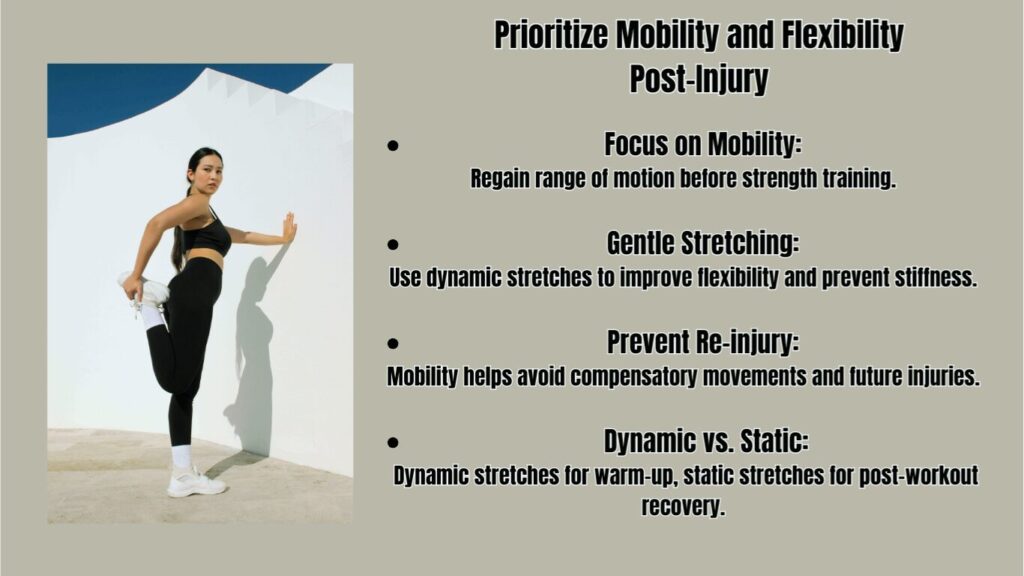
When thinking about how to return to exercise after an injury, it’s crucial to prioritize flexibility and mobility before focusing on strength. Start with gentle, dynamic stretches and mobility drills to improve your range of motion and ease stiffness in the injured area. Flexibility is essential because post-injury stiffness can restrict movement and lead to compensatory patterns that increase your risk of further injury. Improving your mobility early on will give you the foundation you need to move safely and effectively as you begin to rebuild strength and endurance.
Understanding the difference between dynamic and static stretching is also important in ensuring a safe return to exercise. Dynamic stretches before a workout prepare your body for movement, while static stretches afterward help in recovery and preventing stiffness. By incorporating both types of stretching into your routine, you’ll maximize your flexibility and ensure that your muscles are ready for the next stage of your recovery.
In short, focusing on range of motion and flexibility is a key step in learning how to return to exercise after an injury. By taking the time to improve your mobility first, you set yourself up for a smoother, more effective recovery and reduce the risk of re-injury.
Rebuilding Strength: How to Return to Exercise After an Injury(Step 4)
Did you know that muscles start to weaken after just one week of inactivity? This is why it’s so important to approach strength training carefully when you’re figuring out how to return to exercise after an injury. When your body has been sidelined for an extended period, your muscles, tendons, and joints become weaker and more vulnerable to injury. Jumping back into your old strength training routine too quickly can lead to further setbacks. Instead, a gradual approach to rebuilding strength is key to ensuring that you regain your pre-injury fitness without risking re-injury.
Returning to exercise after an injury requires understanding that your body is not at the same level it was before. While the desire to bounce back may be strong, it’s crucial to ease back into strength training to allow your muscles, tendons, and ligaments to adapt without causing additional strain. Strengthening the affected area is a critical step, but the process must be slow and controlled, giving your body time to rebuild muscle while also preventing muscle imbalances and addressing the weaker areas that might have developed during your recovery period.
Practical Tip: Start with Bodyweight Exercises
When thinking about how to return to exercise after an injury, the safest way to begin rebuilding strength is by using bodyweight exercises. These types of exercises, like squats, lunges, push-ups, and planks, are effective because they allow you to strengthen your muscles without putting too much stress on your joints or tendons. Your body is an excellent resistance tool, and starting with movements that rely on your body’s weight allows you to build up your strength gradually.
For example, if you’re recovering from a lower body injury, start with simple exercises like bodyweight squats or lunges. These movements engage the major muscle groups in your legs and core, helping to build strength without adding the extra load of weights. If your upper body was affected, focus on push-ups or plank holds to regain strength in your arms, shoulders, and core. The goal is to get your muscles working again without overloading them with external resistance.
As your strength improves, you can slowly incorporate resistance bands or light weights. Resistance bands are particularly helpful because they allow you to control the tension, providing a gentle but effective way to increase strength without risking injury. The beauty of resistance bands is that they add a progressive challenge as you move through the range of motion, helping you regain strength at your own pace.
Once you feel confident with bodyweight exercises, light weights can be added to your routine. However, the emphasis should remain on control and form rather than on the amount of weight you’re lifting. Adding too much weight too soon can undo the progress you’ve made, so it’s better to start light and build gradually.
Explanation: Why Bodyweight First?
Starting with bodyweight exercises is one of the most effective ways to rebuild strength after an injury because these movements are less likely to stress recovering muscles and joints. After a period of inactivity, muscles lose their strength and stability, making them more susceptible to strain or injury. By focusing on exercises that utilize your body’s weight, you’re allowing your muscles to regain strength naturally without the risk of overloading the injured area.
Additionally, bodyweight exercises help you improve coordination and balance, which may have been affected by the injury. When you perform exercises like lunges or squats, you’re engaging stabilizer muscles that help control the movement. This not only helps you strengthen the affected area but also improves the overall functionality of your body. Using resistance bands can introduce controlled tension in a safe and progressive way, allowing your muscles to adjust to the challenge without risking re-injury. This makes them a great intermediate step before progressing to heavier weights.
Another significant benefit of bodyweight training is that it allows you to focus on proper form. Good form is essential when returning to exercise after an injury, as poor technique can place unnecessary stress on weakened areas and lead to further issues. Bodyweight exercises give you the opportunity to master the movements with minimal risk, which sets the stage for safe and effective progress as you transition to more challenging exercises.
The Importance of Symmetry
One of the challenges of recovering from an injury is addressing muscle imbalances that develop when one side of the body compensates for the injured area. Over time, this compensation can lead to asymmetry, where one side of your body becomes stronger or more flexible than the other. Left unchecked, this imbalance can increase your risk of re-injury or create new problems, such as back or joint pain.
When you’re working on how to return to exercise after an injury, it’s essential to focus on symmetry and ensure that both sides of your body are regaining strength evenly. Pay attention to whether the injured side is weaker or less flexible, and aim to correct any imbalances before moving on to more challenging exercises. This might mean doing extra repetitions or adding more attention to the injured side to bring it up to par with the uninjured side.
For example, if you had a knee injury, it’s common for the opposite leg to become stronger because it’s been taking on more of the load. When you begin your recovery exercises, focus on rebuilding strength equally in both legs to prevent future issues. Exercises that isolate one side of the body, such as single-leg squats or unilateral exercises, can help address imbalances and ensure that both sides are regaining strength in harmony.
Ignoring these imbalances can lead to poor posture, reduced athletic performance, and even increase the risk of chronic pain in areas like the lower back, hips, or shoulders. By taking the time to rebuild strength evenly, you’re not just recovering from your current injury—you’re preventing potential injuries from occurring in the future.
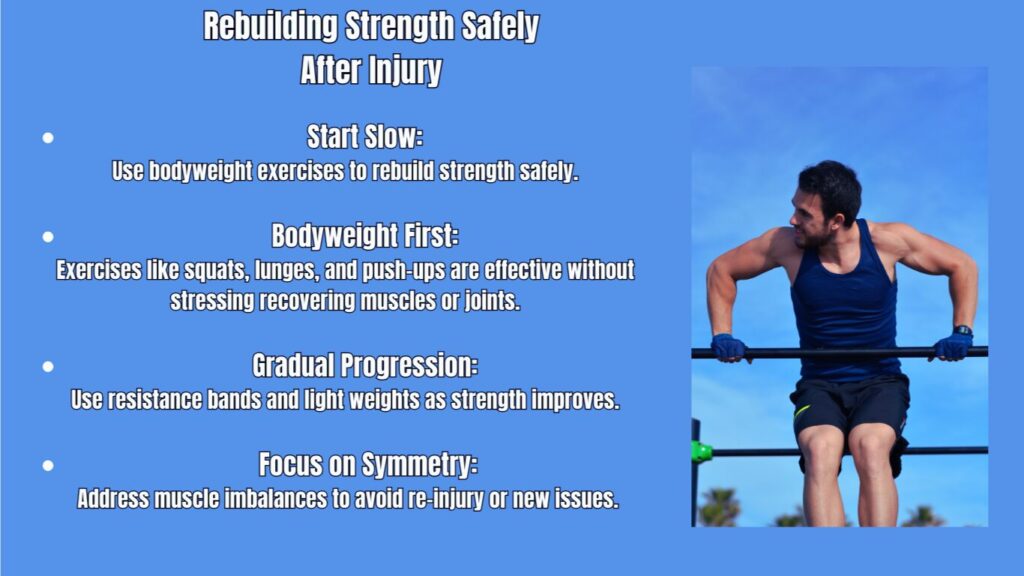
Rebuilding strength after an injury is a delicate process, but it’s a crucial step in learning how to return to exercise after an injury. The key is to start slowly with bodyweight exercises that don’t place too much strain on your recovering muscles and joints. Movements like squats, lunges, and push-ups help you regain strength and stability, while resistance bands allow for progressive tension without the risk of injury.
Starting with bodyweight first is important because it gives your muscles a chance to regain strength gradually, helping you avoid overloading weak areas and preventing re-injury. The next step, as you gain confidence, is to incorporate light weights and gradually increase the intensity of your workouts, all while paying close attention to symmetry and correcting any imbalances that may have developed during your recovery.
By focusing on bodyweight exercises, improving symmetry, and progressing at a controlled pace, you’re setting the foundation for a full recovery. Rushing through this process or skipping steps could lead to setbacks, but by taking it slow and ensuring that your body is rebuilding evenly, you’ll be able to return to your pre-injury fitness levels safely and effectively.
Ultimately, understanding how to return to exercise after an injury means knowing when to push and when to pull back. Rebuilding strength is about creating a balanced approach that gives your body the time it needs to adapt while avoiding unnecessary risks. Stick to the plan, and your body will thank you in the long run.
The chart below shows how quickly muscle atrophy occurs after inactivity due to injury and the typical timeline for muscle recovery when following a gradual, controlled rehabilitation plan. Understanding these phases can help you better plan your return to exercise.
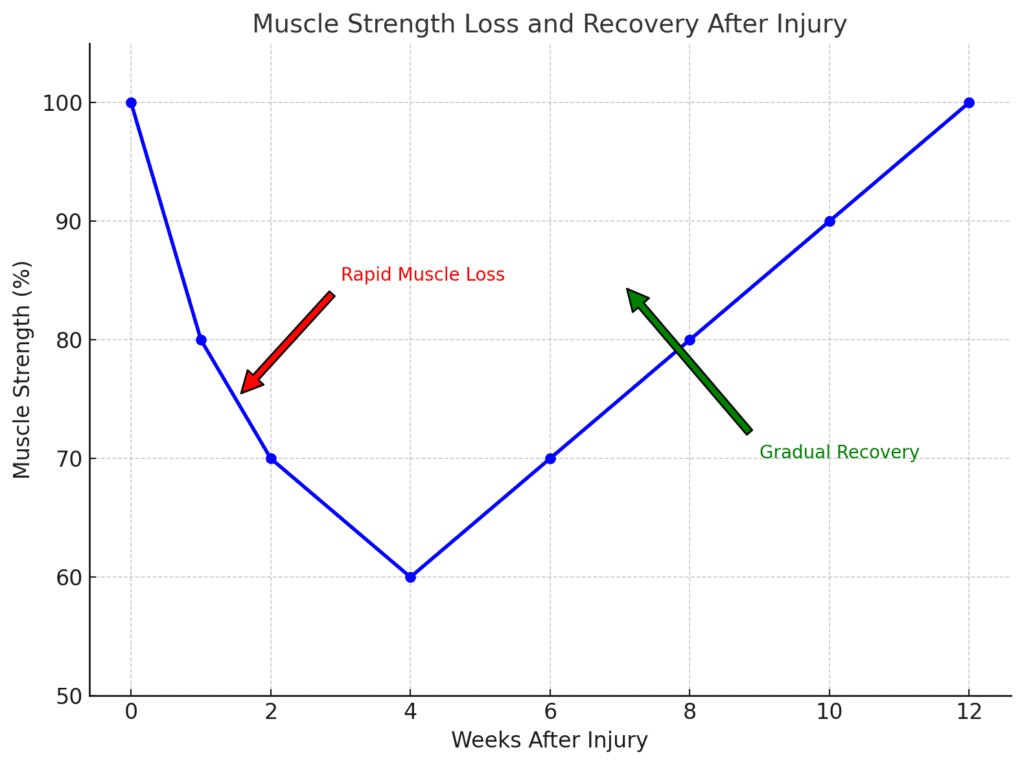
This chart highlights the importance of not rushing the recovery process. While muscles start weakening quickly, rebuilding strength takes time. By pacing your rehabilitation and using methods like bodyweight exercises and light resistance, you can safely regain your pre-injury fitness without risking further setbacks.
The Importance of Rest and Recovery: How to Return to Exercise After an Injury
Did you know that rest and recovery are just as vital as the exercise itself when it comes to healing? Many people overlook this aspect, thinking that the more they work out, the faster they’ll get back to their routine. In reality, understanding how to balance exercise with recovery is crucial for anyone learning how to return to exercise after an injury. Your body does its best healing during periods of rest, not while you’re pushing through your workouts. Prioritizing recovery can make all the difference in your rehabilitation journey, helping you to regain strength without risking further injury.
After an injury, your body requires time to heal. Muscles, tendons, and ligaments need recovery periods to repair and rebuild. This is especially important when you’re returning to exercise. Many athletes or fitness enthusiasts feel the pressure to jump back into their routines as quickly as possible, often leading to overtraining and setbacks. Acknowledging the importance of rest and developing a structured recovery plan is essential in the process of returning to your pre-injury fitness level.
Practical Tip: Use a Rest-Active Rest Ratio
When considering how to return to exercise after an injury, it’s beneficial to start with a rest-active rest ratio. Initially, aim for a higher ratio of rest days to exercise days. A good guideline might be to incorporate three days of rest for every one day of activity. This means that when you first start exercising again, you should be focusing more on allowing your body to recover than on building intensity.
As you progress and your body becomes accustomed to movement, you can begin to shift toward active recovery on your rest days. Active recovery might include gentle activities like stretching, yoga, or light walking. These low-intensity movements promote blood flow and help to alleviate muscle stiffness without overloading your body. It keeps your muscles engaged while giving them a chance to recover, striking the right balance between movement and rest.
For instance, if you’ve started with a few light exercises on a workout day, allow yourself the next few days to rest completely or engage in low-impact activities. This approach helps your muscles recover and prepares them for the next phase of your training.
Explanation: Why Rest Is Essential
Understanding why rest is crucial can significantly impact your recovery when you’re figuring out how to return to exercise after an injury. Your body does not heal while you’re exercising; rather, it heals during periods of rest. When you work out, you place stress on your muscles, leading to small tears. It’s during rest that your body repairs these tears, making your muscles stronger and more resilient.
Overtraining can be detrimental to your recovery. Pushing your body too hard can lead to setbacks such as increased pain, inflammation, or even re-injury. Structured rest is essential because it ensures that your muscles and tendons have adequate time to recover. It’s about creating a balance that allows for progress while respecting your body’s needs.
Failing to include rest days in your routine can also lead to mental burnout. The pressure to perform can be overwhelming, especially after an injury. Incorporating adequate rest helps prevent fatigue and keeps your motivation levels high. By planning for recovery, you’re not just allowing your body to heal; you’re also giving your mind a chance to reset.
Active Recovery vs. Passive Rest
When thinking about how to incorporate rest into your recovery plan, it’s important to differentiate between active recovery and passive rest. Both have their places in your journey back to exercise after an injury, but they serve different purposes.
Passive rest is when you take complete breaks from any physical activity. This might involve lounging on the couch or doing very minimal movement. While this is essential in the initial stages after an injury, too much passive rest can lead to stiffness and reduced mobility. Your muscles need some movement to stay limber, which is where active recovery comes in.
Active recovery, on the other hand, involves engaging in low-intensity activities that promote blood flow and facilitate healing. Gentle walking, stretching, or yoga can help to keep your body active while allowing your muscles to recover. Increased blood flow is beneficial because it helps deliver nutrients to the injured areas, speeding up the healing process. Engaging in active recovery can also help reduce soreness and stiffness, making it easier for you to transition back into more intense workouts.
Incorporating both types of rest into your routine will help you better understand how to return to exercise after an injury. Start with passive rest during the early stages of recovery, gradually moving to active recovery as you feel more comfortable. This combination ensures that your body heals properly while maintaining mobility and flexibility.
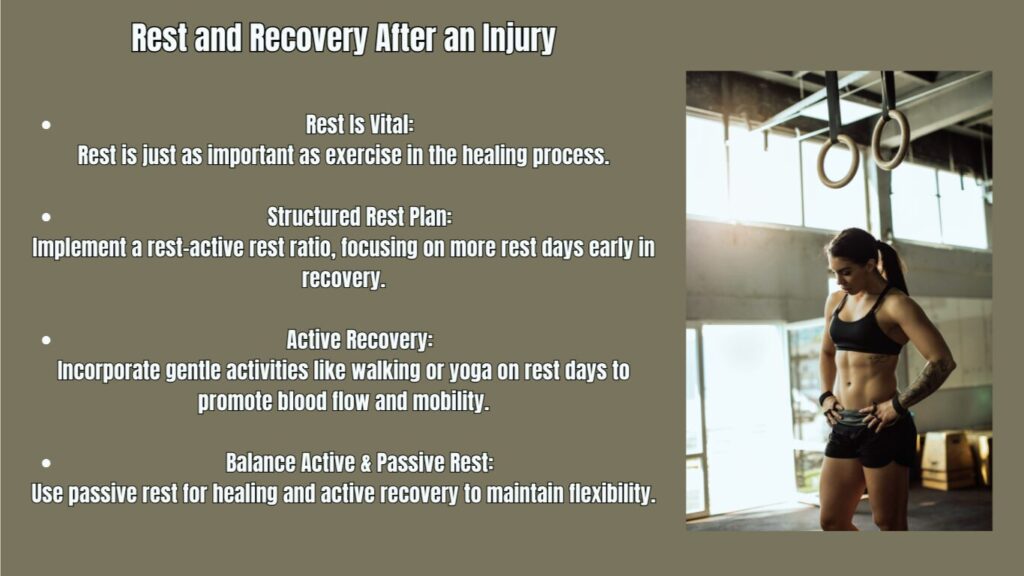
The importance of rest and recovery cannot be overstated when considering how to return to exercise after an injury. Taking the time to implement a structured rest-active rest ratio allows your body to heal effectively. Begin with a higher ratio of rest days to exercise days and transition to active recovery as you progress. This approach helps keep your body engaged while ensuring that your muscles and joints have the opportunity to recover fully.
Understanding why rest is essential, recognizing the signs of overtraining, and balancing active and passive rest will enhance your recovery experience. By prioritizing rest, you set the stage for long-term success, reducing the risk of re-injury and ensuring that your body is ready for the next steps in your fitness journey.
Ultimately, learning how to manage rest effectively is a crucial part of getting back to your exercise routine after an injury. By embracing a thoughtful recovery plan that includes both rest and gentle movement, you’ll not only heal faster but also return to your workouts with renewed strength and resilience. Remember, healing is a process that takes time, and your body deserves the care it needs to thrive.
Reintroducing Cardio: How to Return to Exercise After an Injury
Did you know that cardiovascular exercise plays a vital role in the recovery process after an injury? While it might seem counterintuitive, getting your heart rate up can actually aid in healing by increasing blood flow to affected areas. When considering how to return to exercise after an injury, reintroducing cardiovascular fitness should be a strategic part of your recovery plan. After a period of inactivity, it’s important to ease back into cardio with caution, focusing on low-impact options that promote healing rather than causing additional stress to your body.
After an injury, many people worry about losing their cardiovascular fitness. However, the key is to reintroduce cardio gradually and thoughtfully. Jumping back into high-impact activities can lead to setbacks and re-injury, which is the last thing you want when trying to get back to your normal routine. Understanding how to safely reintegrate cardiovascular training into your regimen is essential for a smooth recovery process.
Practical Tip: Low-Impact Cardio Options
When it comes to how to return to exercise after an injury, starting with low-impact cardio options is the safest way to go. Activities like swimming, cycling, or using an elliptical machine are excellent choices. These exercises allow you to work on your cardiovascular endurance while minimizing stress on your joints and muscles.
For instance, swimming provides a full-body workout without the impact that comes from running or jumping. The buoyancy of the water supports your body, making it easier to move without putting excessive strain on your recovering areas. If swimming isn’t an option, consider cycling or using an elliptical, which also offers a lower-impact alternative to traditional running.
Starting with these low-impact activities allows your body to adapt gradually. Aim to engage in cardiovascular exercise for about 20 to 30 minutes at a time, and focus on maintaining a steady pace rather than pushing for intensity. This will help rebuild your endurance and stamina while still being kind to your body.
Explanation: Why Low Impact First?
Understanding why low-impact cardio should be your first choice is essential when learning how to return to exercise after an injury. High-impact activities like running can stress joints, tendons, and muscles that may not be fully recovered yet. If you were to jump straight back into running, for example, you could risk aggravating your injury or causing new damage, which could set you back even further.
Low-impact cardio helps increase blood circulation, which is crucial for the healing process. Improved blood flow brings necessary nutrients and oxygen to the injured areas, promoting recovery and reducing inflammation. This is particularly important during the early stages of returning to fitness post-injury.
Furthermore, engaging in low-impact activities allows you to maintain cardiovascular fitness without overexerting your body. It helps you retain your stamina and energy levels, making the transition back to your regular routine smoother. By keeping your heart and lungs active, you’ll find it easier to reintegrate higher-impact activities later on without feeling completely out of shape.
In addition, low-impact exercises help build a solid foundation of strength and stability. Strengthening the muscles surrounding your joints will provide better support, making it less likely for you to reinjure yourself when you eventually progress to more challenging workouts. By taking these initial steps carefully, you set yourself up for long-term success in your fitness journey.
Listen to Your Body
As you start reintroducing cardio, it’s essential to listen to your body. Pay attention to how your body responds to each workout. If you experience any pain or discomfort, especially in the area that was previously injured, it’s crucial to stop and reassess your approach. Modifying your activities or giving yourself extra rest days is a sign of wisdom, not weakness.
Every individual’s recovery timeline is different, and what works for one person may not work for another. Consider tracking your progress and how you feel during and after your workouts. This will help you recognize patterns and make informed decisions about how to adjust your cardio routine as you continue to heal.
Progressing to Higher Intensity
Once you feel comfortable with low-impact cardio and have built a solid foundation, you can begin to think about progressing to higher intensity. This doesn’t mean jumping straight into high-impact workouts; rather, consider gradually increasing the intensity of your low-impact activities first. For example, if you’ve been swimming, try incorporating faster intervals into your routine or increasing the resistance on the elliptical machine.
The key is to make incremental changes. You might start with short bursts of increased intensity for just a few minutes at a time. As your body adapts, you can increase the duration and intensity more. This gradual approach helps ensure that your muscles and joints are ready for the added challenge, allowing you to maintain progress without risking injury.
Incorporating Variety
When thinking about how to return to exercise after an injury, incorporating variety into your cardiovascular routine can also keep things engaging and beneficial. Consider mixing different low-impact activities to work various muscle groups. For instance, alternating between swimming and cycling not only helps prevent boredom but also ensures that you’re engaging different muscles and giving others a chance to recover.
You can also explore other low-impact options such as rowing or aqua aerobics. These activities can provide a refreshing change of pace while still aligning with your recovery goals. Variety keeps you motivated and ensures that you’re working on overall fitness, which is important for a balanced recovery.

Reintroducing cardiovascular fitness is a crucial step in learning how to return to exercise after an injury. By focusing on low-impact cardio options like swimming, cycling, or using an elliptical, you can rebuild your cardiovascular endurance while minimizing stress on your joints and muscles. Understanding the importance of low-impact exercise in promoting blood circulation and aiding recovery will help you make informed decisions as you progress.
Listen to your body and track your progress to ensure that you’re making strides without pushing too hard. Gradually increasing intensity and incorporating a variety of activities will help keep your workouts engaging and effective. Remember, recovery takes time, and honoring your body’s needs during this process is essential for long-term success.
Ultimately, by prioritizing low-impact cardio and following a thoughtful progression, you’ll be well on your way to reclaiming your fitness and returning to the activities you love, all while safeguarding your health and well-being.
Cross-Training for Injury Prevention (Step 7: Vary Your Workouts)
Did you know that cross-training can significantly lower your risk of re-injury? When you’re recovering from an injury, it’s tempting to jump back into the same workouts you were doing before. However, understanding how to return to exercise after an injury means recognizing the importance of mixing things up. By incorporating a variety of activities, you can promote balanced strength and flexibility, enhancing your overall fitness while minimizing the chances of repeating the same injury.
When you’re on the road to recovery, it’s crucial to approach your fitness routine thoughtfully. Relying solely on the same exercises you did prior to your injury can place undue stress on the same muscle groups, increasing the risk of re-injury. Instead, embracing cross-training offers a safe and effective way to rebuild your fitness. Not only does it provide a comprehensive workout for your body, but it also keeps your routine fresh and engaging.
Practical Tip: Incorporate Different Activities
As you consider how to return to exercise after an injury, one of the best strategies is to incorporate different activities into your routine. This could mean adding yoga, Pilates, or strength training to your schedule alongside your regular workouts. By varying your activities, you can create a balanced approach to fitness that supports recovery and prevents future injuries.
For example, if you were primarily a runner before your injury, think about integrating low-impact exercises like swimming or cycling into your routine. You might also explore strength training, which can help build muscle and joint stability without putting excessive strain on your body. Activities like yoga or Pilates can improve flexibility, balance, and core strength, which are crucial for injury prevention.
By mixing different types of workouts, you allow your body to recover while still staying active. This balanced approach ensures that you’re not overloading specific muscle groups, which can lead to fatigue and potential injury. It also keeps your workouts interesting, making it easier to stay motivated and committed to your recovery.
Explanation: Why Cross-Training?
Understanding why cross-training is beneficial is essential when learning how to return to exercise after an injury. Engaging in a variety of exercises helps strengthen different muscle groups, improving your overall fitness. When you focus on a single type of exercise, you risk overloading specific areas of your body, which can lead to repetitive strain injuries.
By incorporating different activities into your routine, you distribute the workload more evenly across your body. This not only helps prevent injury but also enhances your overall performance. For instance, a strong core can improve your balance and stability, making you less prone to falls and injuries. Flexibility gained from yoga can help prevent muscle tightness that often leads to injuries during workouts.
Cross-training also promotes joint stability, which is crucial for anyone recovering from an injury. Many injuries stem from weaknesses in surrounding muscles that fail to support the joint properly. By strengthening these supporting muscles through various exercises, you enhance the stability of your joints and reduce the risk of future injuries.
Moreover, cross-training can improve your cardiovascular endurance, flexibility, and strength, creating a more well-rounded fitness profile. This holistic approach helps you become a more versatile athlete, enabling you to tackle a wider range of activities without fear of injury.
Listening to Your Body
As you begin to incorporate different activities into your routine, it’s important to listen to your body. Pay attention to how you feel during and after workouts. If certain exercises aggravate your injury, consider modifying them or choosing alternatives that feel more comfortable.
Each person’s recovery journey is unique, and your body will guide you in finding the right balance. It’s essential to be patient with yourself during this process. If you experience discomfort or fatigue, it might be a sign to dial back the intensity or frequency of your workouts.
Setting a Balanced Routine
When figuring out how to return to exercise after an injury, aim to create a balanced routine that incorporates a variety of activities. For instance, you might designate specific days for strength training, while reserving others for flexibility work like yoga or Pilates.
A well-structured week could look something like this:
- Monday: Strength training focused on upper body
- Tuesday: Yoga or Pilates for flexibility and core strength
- Wednesday: Low-impact cardio like cycling or swimming
- Thursday: Strength training for lower body
- Friday: Active recovery with light stretching or walking
- Saturday: A fun activity that incorporates movement, like a hike
- Sunday: Rest and recovery
This type of schedule ensures that you are not overloading any specific muscle group while still remaining active and engaged in your fitness journey.
Incorporating Fun Activities
One of the great aspects of cross-training is that it allows you to incorporate fun activities into your routine. Explore different classes, outdoor adventures, or team sports that pique your interest. Not only does this keep you motivated, but it also allows you to enjoy the process of getting back into shape.
Engaging in activities that you love can make your recovery feel less like a chore and more like an enjoyable journey. Consider joining a local group for hiking, dance classes, or even martial arts. The social aspect can also be uplifting and provide additional encouragement as you work on your fitness goals.
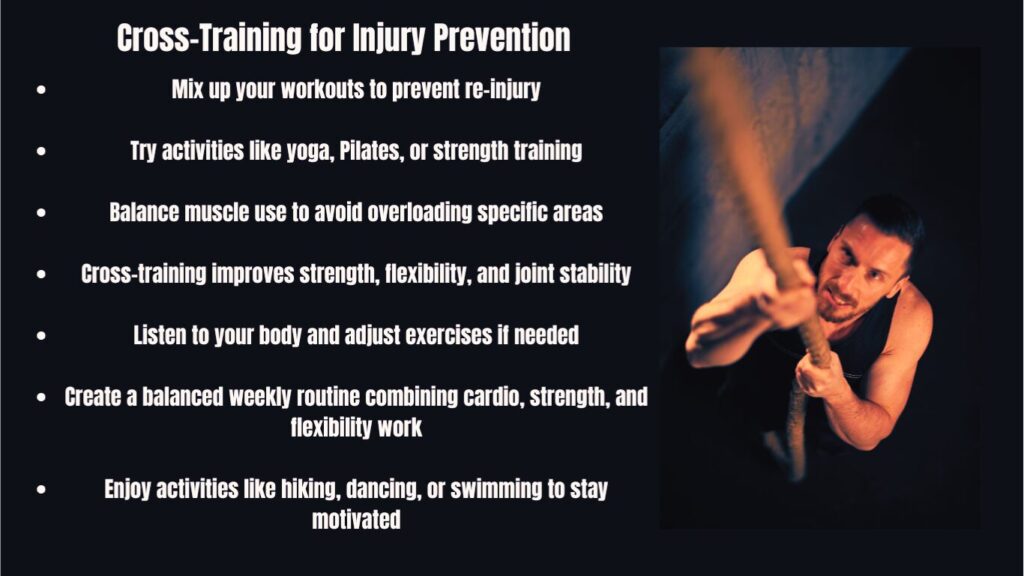
Cross-training is an essential component of learning how to return to exercise after an injury. By incorporating different activities such as yoga, Pilates, or strength training into your routine, you create a balanced approach to fitness that minimizes the risk of re-injury. Understanding the benefits of mixing exercises strengthens various muscle groups and improves joint stability.
Listening to your body and creating a well-rounded routine will support your recovery journey. Incorporating enjoyable activities into your fitness regimen makes the process more engaging and sustainable. Remember, recovery takes time and patience, but with the right approach, you can emerge stronger and more resilient than ever.
Use Tools for Support (Step 8: Consider Support Gear and Tools)
Did you know that using support gear can significantly aid your recovery process after an injury? When learning how to return to exercise after an injury, many people overlook the benefits that braces, compression sleeves, and kinesiology tape can provide. These tools are designed to offer external stability, helping you feel more secure as you resume physical activity. However, it’s essential to understand how and when to use these supports effectively to ensure they enhance your recovery rather than hinder it.
As you begin to reintroduce exercise into your routine, you may notice lingering weakness in the injured area. This is where support gear can play a crucial role. By providing stability and comfort, these tools can give you the confidence to engage in physical activity again. However, it’s important to strike a balance—while support gear can be helpful, becoming overly reliant on them can actually lead to further issues down the line.
Practical Tip: Use Braces or Tape
When figuring out how to return to exercise after an injury, consider using braces or tape to help stabilize the affected area. Compression sleeves can improve blood circulation and reduce swelling, while braces provide structural support that limits excessive movement. Kinesiology tape can help in stabilizing muscles and joints, offering support during various activities.
For example, if you’re returning to running after an ankle injury, wearing an ankle brace can help stabilize the joint and reduce the risk of re-injury. Similarly, if you’ve experienced a shoulder injury, using kinesiology tape can help maintain proper alignment and function as you gradually increase your activity level.
While these tools can be beneficial, it’s important not to become overly dependent on them. They should serve as temporary aids to help you transition back to exercise safely. Incorporating them into your routine can provide the necessary support, but they should not replace your body’s natural ability to heal and strengthen.
Explanation: Why Use Support Gear?
Understanding why support gear is helpful is crucial when learning how to return to exercise after an injury. These tools offer external stability, allowing your muscles to regain strength gradually without the risk of overexertion. This is particularly important during the early stages of your recovery, when your body is still adjusting and healing.
Support gear can help prevent further injury by providing a controlled environment for your muscles and joints. For example, a knee brace can limit excessive movement that might aggravate an injury, while compression sleeves can enhance blood flow to the area, facilitating healing. By offering this additional layer of support, you can engage in your activities with greater confidence and less fear of re-injury.
However, it’s important to be aware that relying too heavily on support gear can have downsides. Prolonged use can lead to muscle weakness, as your body may become accustomed to the external support rather than relying on its own strength. This can create a cycle where the muscles do not regain their full strength, leading to dependence on the support gear.
When to Phase Out Support Gear
A key aspect of effectively using support gear involves knowing when to phase it out. As your muscles and joints grow stronger, it’s important to gradually reduce your reliance on these tools. Continuing to use support gear indefinitely can inhibit your body’s natural recovery process, preventing you from achieving your full potential.
Start by monitoring how you feel during workouts. If you notice that your strength and stability are improving, consider using support gear only during more challenging activities or high-impact exercises. For instance, you might choose to wear a brace during a long run but not during shorter, easier walks or gentle workouts.
As you become more confident in your abilities, try gradually reducing the frequency of your support gear usage. For example, you could decide to skip the brace during some workouts or only use it when you feel fatigued or unsure about your stability. This gradual approach helps your body adapt while still providing a safety net during your recovery.
It’s also beneficial to consult with a healthcare professional, such as a physical therapist, to determine the best timeline for phasing out support gear. They can provide tailored advice based on your specific situation and help you develop a plan for regaining strength and stability without reliance on external tools.
Incorporating Strengthening Exercises
As you begin to phase out support gear, it’s important to complement this process with strengthening exercises. Focus on building the muscles around the injured area to provide natural stability. For instance, if you’re recovering from a knee injury, incorporating exercises that strengthen your quadriceps, hamstrings, and calves can enhance overall joint stability.
This can include exercises like bodyweight squats, lunges, or specific resistance band workouts tailored to your needs. Gradually increasing the intensity and complexity of these exercises will help your body adjust and strengthen in a controlled manner.
Listening to Your Body
Throughout this process, it’s crucial to listen to your body. Pay attention to any discomfort or signs of fatigue, and adjust your use of support gear accordingly. If you notice pain or instability while reducing reliance on support tools, it may be necessary to incorporate them back into your routine temporarily.
Regularly assessing how you feel during and after workouts will guide your decision-making process. It’s all about finding a balance that allows you to progress while ensuring your safety and recovery.
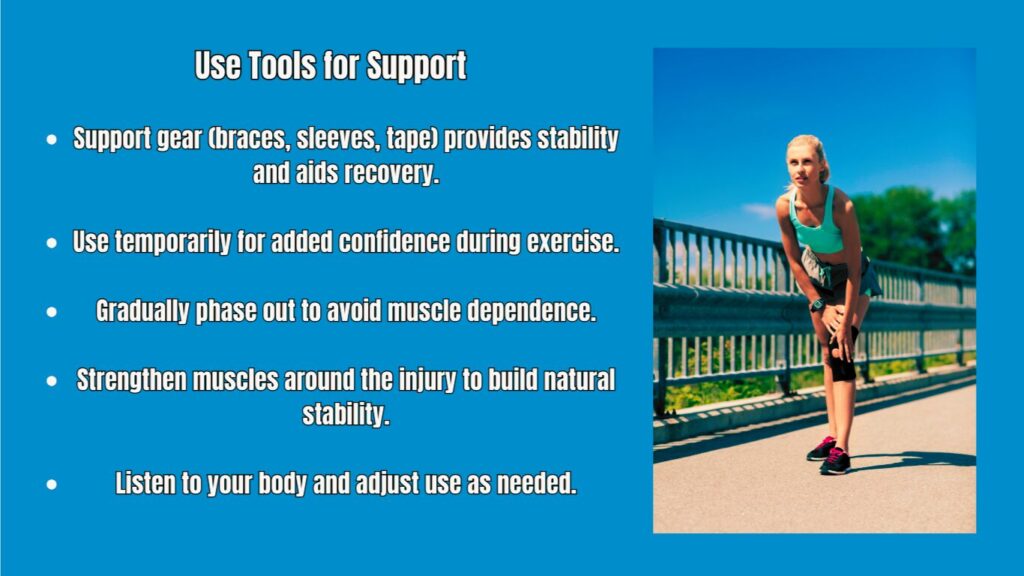
Using tools for support is an essential step in learning how to return to exercise after an injury. By incorporating braces, compression sleeves, or kinesiology tape, you can provide the stability necessary to safely engage in physical activity as you recover. However, it’s important to strike a balance and not rely too heavily on these aids.
Understanding the benefits of support gear, knowing when to phase it out, and incorporating strengthening exercises will help you regain strength and stability. As you listen to your body and adjust your routine, you’ll be well on your way to a successful return to fitness. By taking these steps thoughtfully, you can ensure a safe, effective, and enjoyable journey back to your active lifestyle.
Mental Recovery and Confidence (Step 9: Overcoming Fear of Re-injury)
Did you know that mental recovery can be just as crucial as physical recovery after an injury? When learning how to return to exercise after an injury, many individuals focus solely on physical rehabilitation, neglecting the mental aspects of their recovery journey. It’s not uncommon to feel anxious or fearful about re-injury when you start exercising again. This fear can be a significant barrier to achieving your fitness goals and can hinder your progress. Addressing these mental challenges is essential for building confidence and resuming a fulfilling active lifestyle.
After an injury, it’s perfectly natural to feel apprehensive about returning to your previous level of activity. You may find yourself questioning whether your body can handle the same workouts you did before, or worrying that you’ll re-aggravate your injury. These thoughts can create a cycle of anxiety that holds you back, making it even more difficult to resume your routine. Understanding that these feelings are normal is the first step in overcoming them.
Practical Tip: Visualize Success
One effective strategy for overcoming the fear of re-injury is to visualize success. Visualization is a powerful mental technique that involves picturing yourself successfully engaging in activities without pain or setbacks. By creating a clear mental image of what you want to achieve, you can help your brain adapt to the idea of returning to exercise confidently.
Spend a few minutes each day imagining yourself participating in your chosen activity—whether it’s running, lifting weights, or practicing yoga. Visualize the movements, how it feels to be strong and capable, and the satisfaction that comes from completing a successful workout. This mental rehearsal can help condition your mind to feel more prepared and less anxious about getting back into your routine.
Additionally, positive self-talk can play a significant role in overcoming fear. Instead of allowing negative thoughts to take hold, actively replace them with affirmations that reinforce your capabilities. Phrases like “I am strong and capable,” or “I trust my body to handle this,” can help shift your mindset and build confidence over time.
Explanation: Why Mental Recovery Matters
Understanding why mental recovery is important is key when discussing how to return to exercise after an injury. Physical rehabilitation often focuses on rebuilding strength, flexibility, and endurance, but it’s equally important to address the psychological barriers that may arise during this process. The fear of re-injury can significantly impact your motivation and willingness to push yourself during workouts, ultimately affecting your overall progress.
Research shows that mental factors such as anxiety and fear can influence physical performance. If you’re constantly worried about re-injury, you may subconsciously hold back during workouts, preventing you from fully engaging in the movements. This hesitation can create a feedback loop where your performance suffers, leading to even more anxiety and fear.
Addressing these mental barriers is not only about enhancing performance; it’s also about promoting a healthier mindset toward fitness. When you learn to overcome fear and build confidence, you empower yourself to pursue your fitness goals more freely. This mental resilience can lead to a more positive experience overall, making your return to exercise not just a physical journey, but a fulfilling one as well.
Building a Support System
Another essential aspect of mental recovery is surrounding yourself with a supportive community. Sharing your concerns and experiences with friends, family, or fellow athletes can provide the encouragement you need to overcome your fears. Having a network that understands what you’re going through can offer reassurance and motivation.
Consider joining a local fitness group or finding a workout buddy who shares similar goals. Working out with others can provide a sense of accountability and make the process more enjoyable. Plus, being around people who are also focused on recovery can help normalize your feelings and make you feel less isolated in your journey.
Setting Incremental Goals
As you learn how to return to exercise after an injury, setting small, achievable goals can also help alleviate fear and build confidence. Rather than aiming for an ambitious target right away, break your goals down into manageable steps. This approach allows you to focus on gradual progress, which can be less intimidating than jumping straight back into high-intensity workouts.
For example, if you’re recovering from a knee injury and want to return to running, start by setting a goal to walk for a certain amount of time each day. Once you feel comfortable with that, gradually increase your walking duration and pace before transitioning to light jogging. Celebrate each small victory along the way to reinforce your progress and build confidence.
Practicing Mindfulness
Incorporating mindfulness practices into your routine can also be beneficial for mental recovery. Mindfulness involves being present in the moment and can help you manage anxiety and fear. Techniques such as deep breathing, meditation, or yoga can cultivate a sense of calm and focus.
By practicing mindfulness, you can train your mind to stay grounded and present during workouts, rather than getting lost in worries about the future. This focus can enhance your overall workout experience and help you develop a healthier relationship with exercise.
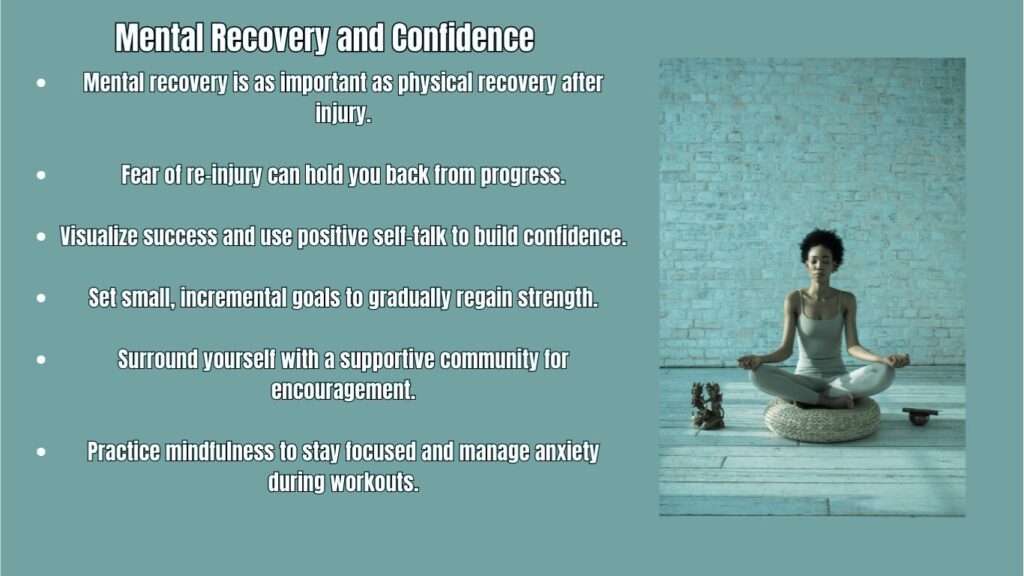
Addressing mental recovery is a vital part of learning how to return to exercise after an injury. Overcoming the fear of re-injury is essential for regaining confidence and achieving your fitness goals. By employing strategies such as visualization, positive self-talk, and setting incremental goals, you can combat anxiety and create a more empowering mindset.
Building a supportive network and practicing mindfulness can further enhance your mental resilience as you navigate your recovery journey. Remember, both mental and physical recovery take time, so be patient with yourself. By acknowledging and addressing your fears, you’re taking significant steps toward a successful and fulfilling return to exercise. Embrace this journey, and allow yourself to grow stronger—both physically and mentally.
Monitoring Progress and When to Seek Help (Step 10: Know Your Limits)
As you embark on the journey of how to return to exercise after an injury, one of the most crucial aspects to consider is monitoring your progress. Did you know that keeping track of your recovery can significantly enhance your ability to bounce back? Many people overlook this important step, focusing solely on physical exertion. However, actively tracking your progress can provide insights that help you make informed decisions about your fitness journey.
When returning to exercise, it’s vital to understand your body and recognize its limits. Injuries can create new challenges that require careful attention. You may feel eager to push yourself, but without proper monitoring, you risk re-injury or setbacks. That’s why establishing a structured approach to tracking your activity, pain levels, and improvements is essential.
Practical Tip: Track Your Progress
One effective method to stay on top of your recovery is to keep a journal or use an app designed for tracking workouts and progress. Documenting your activity levels, pain responses, and any changes you notice can provide a clear picture of your journey. This record will help you identify patterns, such as when your pain increases or decreases relative to specific activities.
By monitoring your progress, you can make informed adjustments to your exercise routine, ensuring you stay within your limits while gradually increasing intensity. If you notice consistent pain or discomfort during certain movements, this is a critical signal to reassess your approach.
Additionally, tracking your improvements can be incredibly motivating. Celebrate small victories, whether it’s a longer walk, more reps, or reduced pain levels. These achievements remind you that progress is possible and encourage you to stay committed to your recovery.
Know When to Get Help
Another key aspect of successfully learning how to return to exercise after an injury is knowing when to seek professional help. If you experience a resurgence of pain or notice that your symptoms are worsening, it’s essential to stop and consult a healthcare professional immediately. Ignoring pain can lead to more significant setbacks, so it’s crucial to listen to your body.
Don’t hesitate to reach out for help if you’re unsure about the severity of your pain or how to adjust your activities. A doctor, physical therapist, or sports medicine specialist can provide valuable insights and guidance tailored to your specific situation. They can help you navigate the complexities of recovery and ensure that you’re following a safe and effective plan.
Explanation: Why Tracking Helps
Monitoring your progress offers several benefits that are crucial for your recovery. Firstly, it allows you to identify patterns in your body’s response to different activities. By tracking when pain occurs and when you feel strong, you can better understand what works for you and what doesn’t. This insight can help you make educated decisions about how to adjust your routine for optimal recovery.
Additionally, tracking progress can prevent overexertion. It’s easy to push yourself too hard, especially when you start feeling better. However, knowing your limits and recognizing signs of fatigue or pain will help you avoid unnecessary setbacks. You can use your records to create a balanced workout plan that emphasizes gradual progression rather than rushing back into high-intensity activities.
Understanding Setbacks
Setbacks are a natural part of the recovery process, especially when learning how to return to exercise after an injury. It’s essential to recognize that experiencing a setback does not indicate failure. Rather, it serves as a signal that you may need to reevaluate your approach. Injuries can be unpredictable, and your body might react differently on certain days.
Understanding this can alleviate the frustration that often accompanies setbacks. Instead of viewing them as roadblocks, consider them opportunities for learning. Analyze what might have led to the setback—did you push too hard, or were your movements not aligned properly? This analysis will help you adjust your strategy and continue progressing.
Moreover, maintaining a positive mindset is vital. Focus on the progress you’ve made rather than the challenges you encounter. Remember that recovery is not a linear path; it involves ups and downs. By adopting a resilient attitude, you’ll be better equipped to face the obstacles that come your way.
Combining Tracking with Professional Guidance
As you learn how to return to exercise after an injury, combining your tracking efforts with professional guidance can significantly enhance your recovery. Regular check-ins with a healthcare provider can provide additional insights that complement your observations. They can help interpret the data you’ve gathered and suggest adjustments to your routine based on your progress.
For instance, if you’ve been tracking your workouts and notice persistent pain during specific exercises, your healthcare provider may suggest modifications or alternative activities to keep you on track while ensuring safety. Their expertise can guide you in making adjustments that you may not have considered, leading to a more effective recovery.
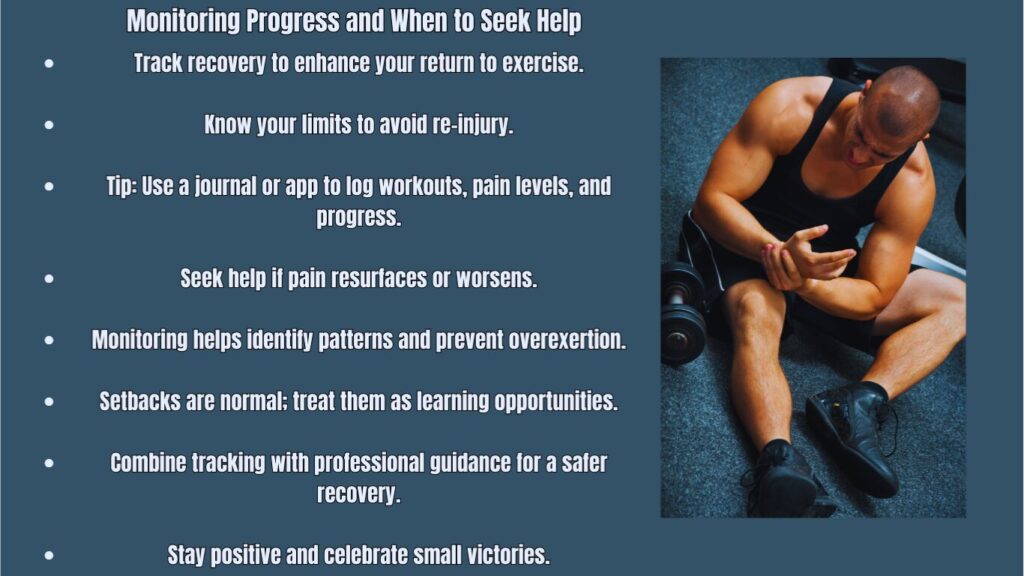
Monitoring progress is a critical component of successfully navigating how to return to exercise after an injury. By keeping a detailed record of your activities and pain levels, you empower yourself to make informed decisions about your recovery. Knowing when to seek help is equally important, as professional guidance can ensure that you’re following a safe and effective path.
Remember, setbacks are a normal part of the recovery journey and provide opportunities for learning and growth. Stay positive and focus on the progress you make, celebrating every small victory along the way. With patience, diligence, and the right strategies, you can successfully return to exercise while building a stronger foundation for your fitness journey.
Final Thoughts on How to Return to Exercise After an Injury: Key Steps and Encouragement
Returning to exercise after an injury can be challenging, but following a structured approach can help you navigate this journey successfully. Here’s a comprehensive summary of the how to return to exercise after an injury process, with explanations for each step:
- Listen to Your Body:
- Why It’s Important: Understanding the difference between pain and discomfort is crucial for safe progression. Tuning into your body’s signals helps prevent further injury.
- Be Patient and Start Slow:
- Why It’s Important: Gradual progression allows your body to adapt without overwhelming it, reducing the risk of re-injury and supporting long-term recovery.
- Focus on Range of Motion Before Strength:
- Why It’s Important: Improving flexibility and mobility is essential for regaining full function and preventing stiffness that can lead to re-injury.
- Rebuild Strength Gradually:
- Why It’s Important: Starting with bodyweight exercises helps strengthen the affected area without overloading your joints, laying a solid foundation for recovery.
- Incorporate Low-Impact Cardio:
- Why It’s Important: Low-impact activities minimize stress on the body while rebuilding cardiovascular endurance, promoting overall health during recovery.
- Cross-Train for Injury Prevention:
- Why It’s Important: Mixing different activities strengthens various muscle groups and reduces the risk of overloading one area, helping prevent future injuries.
- Consider Support Gear:
- Why It’s Important: Support gear like braces or tape can provide stability during recovery. However, it’s crucial to avoid over-reliance to prevent weakening muscles.
- Understand the Importance of Rest and Recovery:
- Why It’s Important: Rest is when your body heals. Incorporating rest days and active recovery ensures muscles and tendons have adequate time to recover.
- Overcome the Fear of Re-injury:
- Why It’s Important: Addressing psychological barriers and building confidence is essential for a successful return to exercise, allowing you to push your limits safely.
- Track Your Progress:
- Why It’s Important: Monitoring your activity and improvements helps you identify patterns, prevent overexertion, and know when to push forward in your recovery.
- Know When to Seek Help:
- Why It’s Important: Recognizing when to consult a professional ensures you’re addressing any setbacks appropriately, which is vital for a safe and effective recovery.
By reinforcing these steps, you can create a solid foundation for your recovery and ensure a safer return to your fitness routine.

Final Encouragement
Recovery takes time. While the journey may feel frustrating, a thoughtful and methodical approach will help you regain your fitness while minimizing future injuries. Embrace the process and celebrate your progress, no matter how small.
Suggested Reading on the Topic
To deepen your understanding of injury recovery and fitness, consider these books:
- “The Healing Power of Exercise” by Dr. Richard J. Cohen
This book explores the connection between physical activity and healing, offering insights into using exercise as a tool for recovery. - “Rebound: Train Your Mind to Bounce Back Stronger from Sports Injuries” by Dr. Jim Afremow
A comprehensive guide that focuses on the mental aspects of recovery, providing strategies to help athletes regain confidence and resilience. - “Strong Inside: The True Story of How I Came Out and Triumphed Against the Odds” by L. C. R. Smith
An inspiring memoir illustrating the power of determination in overcoming obstacles, including physical challenges. - “The New Rules of Lifting for Life” by Lou Schuler and Alwyn Cosgrove
This book emphasizes safe lifting techniques and progressive training, ideal for those returning to exercise post-injury.
With these resources, you can continue to educate yourself on the journey of recovery. Remember, you are not alone in this process, and with the right mindset and strategies, you can successfully return to exercise after an injury.
